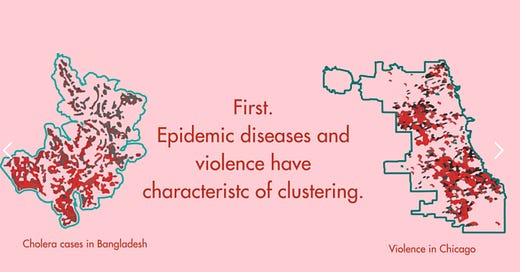Violence is predictable. And, if it’s predictable, it’s preventable.
For those of you that don’t know, I’m a violence epidemiologist “during the day”. Our theory is that violence is contagious. We’ve shown time and time again, that clusters of violence mirror clusters of infectious disease. This means that violence is not random, its predictable. And if it’s predictable, it’s preventable.
Violence epidemiology started to emerge about 40 years ago, but only recently gained momentum. The most famously studied is suicide clustering. In other words, we have scientific evidence to show that if a child or an adult witnesses suicide, or hears about it on the news, or knows a friend that committed suicide, they’re more likely to have suicidal thoughts and, in some cases, even attempt it. This is important work because if we know the patterns of suicide, epidemiologists are able to develop interventions to stop the “disease” in its path. For example, studies have found that high-school environments can be changed in order to stop the spread of suicidal thoughts among adolescents.
Other areas of violence epidemiology, like mass shootings, have been harder to study.
Why? There are several reasons, but the most blaring is the lack of funding. In 1993, there was a famous study published in the New England Journal of Medicine that found having a gun in the home increased the risk of homicide in the home. This set off a political domino effect and, three years later, the Dickey Amendment was inserted into the CDC spending bill by Congress. The provision stated “none of the funds made available for injury prevention and control at the Centers for Disease Control and Prevention (CDC) may be used to advocate or promote gun control.” The problem with this, though, is that the language was unclear. The violence epidemiologist of the 1993 study famously said, “Precisely what was or was not permitted under the clause was unclear. But no federal employee was willing to risk his or her career or the agency's funding to find out. Extramural support for firearm injury prevention research quickly dried up."
This set gun violence research back decades. Epidemiological research is mainly funded by federal money. So, we couldn’t conduct large, population-based studies to find patterns of gun violence, like mass shootings. If we weren’t allowed to find patterns, then we couldn’t find evidence-based solutions. This, ladies and gentleman, has plagued the United States.
There is good news, though.
Fortunately, this didn’t stop non-profit foundations from funding the research. They certainly don’t have the dollars like the federal government, but can support local, community research projects. From this grassroots movement, we’ve been able to find some patterns, like:
Intimate partner homicide (e.g. domestic abuse) and guns
How gun owners live safely with their guns (and what we can learn from them)
Mental health and gun use
Technology and gun storage
Also, fortunately, in 2020 -for the first time in 25 years- our federal budget included $25 million for the CDC and NIH to research reducing gun-related deaths and injuries. This may seem like a lot of money, but it isn’t enough to reflect the public health crisis. A study in 2017 estimated that we need $1.4 billion to curb this epidemic. In comparison, the NIH gets $6.56 BILLION allocated for cancer research. Also, the Dickey Amendment still remains today, the wording is just a bit edited.
There are ways in which we can live with firearms and gun violence prevention in the same community.
Yes, it’s possible. However, we need to get more aggressive with research. Gun violence research doesn’t mean we take away guns (hell, if that were the case my husband would hate my day job). But, we need to figure out patterns of gun violence (like what predicts mass shootings). If we can figure out the patterns, we can figure out how to prevent mass shootings in data-driven, evidence-based ways.
I promise it can be done. We, as a nation, just need to commit.
Love, your local (violence) epidemiologist






Fascinating information, please keep sharing!!! I'm not a gun-owner, but I don't want to take that right away from anyone else. I love my kids and I want them to be safe. There's a balance, I know, and people like you can help us find this.
This is fantastic. Your approach do laying out data is really appreciated -- offering your analysis, but also presenting conflicting analysis as valid. I wish more journalism outlets would take this approach. Covid, gun violence, or anything else you want to cover, I'm in.